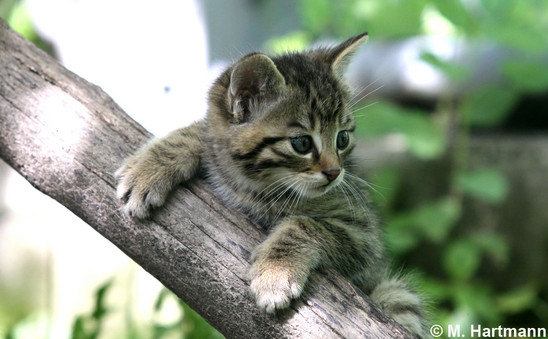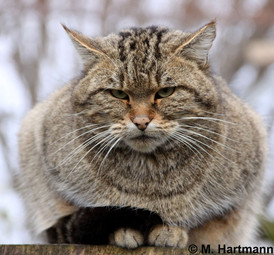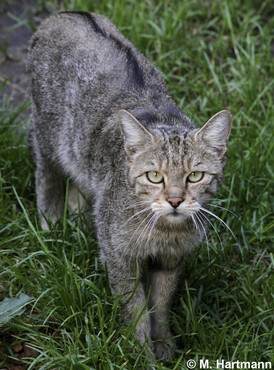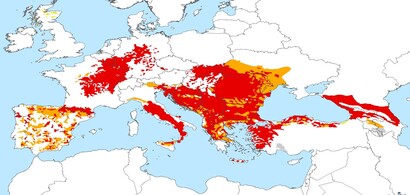European wildcat
Felis silvestris
IUCN Red List: LC
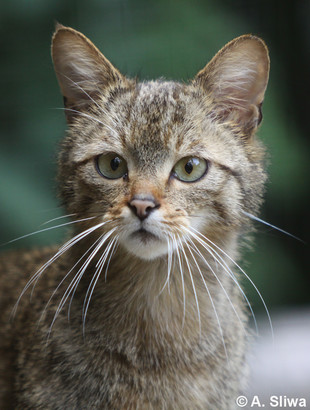
| Weight: | 3–8 kg |
| Body length: | 45–80 cm |
| Tail length: | ca. 30 cm |
| Longevity: | 10 years in the wild, 12–16 in captivity |
| Litter size: | 1–8 cubs |
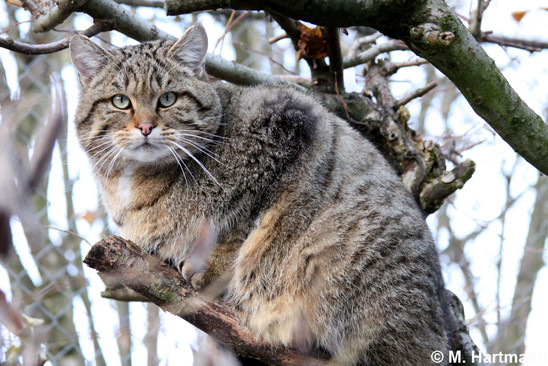
Description
The revised taxonomy of the Felidae recognises the following species of the Genus Felis: Felis chaus (Jungle cat), Felis nigripes (Black-footed cat), Felis margarita (sand cat), Felis bieti (Chinese mountain cat), Felis silvestris (European wildcat), Felis lybica (African wildcat) and Felis catus (domestic cat). The European wildcat (Felis silvestris) includes only the forest cats of Europe. Despite limited information on morphological and genetical differences between the two subspecies being available, two subspecies of the European wildcat are proposed based on current geographical isolation:
- Felis silvestris silvestris in Europe, including Scotland, Sicily and Crete and
- Felis silvestris caucasica in the Caucasus and Turkey.
Fossil records indicate that the European wildcat is the oldest form descended from Martelli’s cat (Felis silvestris lunensis) about 250,000 years ago. The only ancestor of the domestic cat is F. lybica. Hybridisation is common between European wildcats and domestic cats, as well as between African wildcats and domestic cats. Hybridisation between European and African wildcats can occur when ranges overlap as well, e.g. a possible contact zone in the southern Caucasus and in eastern and southern Anatolia.
The European wildcat is the size of a large domestic cat. It has a broad head and wide set ears. The coat of the European wildcat is thick and long (during the wintertime), grey-brown with a well-defined, individual pattern of black stripes on the head, neck, limbs, and has a distinct dorsal line. The European wildcat has a bushy, blunt-ending tail with several black rings and a black tip. Some individuals have a white spot on the throat. In its winter coat, the European wildcat looks rather compact and short-legged, although this cat actually has longer legs than most domestic cats. Melanistic individuals have never been recorded in Europe.
Languge/Country | Name |
|---|---|
Albanian | macja e egër |
Arabic | Al qit |
Armenian | vairi katu, antarayin katu |
Azerbaijani | Vəhşi pişik |
Basque | Basakatua |
Bulgarian | diwa kotka |
Corsican | ghjattu volpe |
Croatian | Mačka divlja |
Czech | koka divoká |
Dutch | Wilde kat |
English | Wildcat |
French | chat forestier, chat silvestre |
Georgian | tkis cata |
German | Wildkatze |
Greek | Άγρια γάτα (Agriogata) |
Hungarian | vadmacska |
Italian | gatto selvatico |
Macedonian | Дива мачка (Diva machka) |
Polish | bik |
Portugese | gato bravo, gato cabe |
Romanian | pisic slbtic |
Russian | dikaja koschka |
Serbian | Divlja mačka |
Slovakian | maka diva |
Spanish (Castilian) | gato montés, gato silvestre |
Spanish (Catalan/Valencian) | Gat fer |
Turkey | yaban kedisi |
Wallon (Belgium) | sauvadge tché |
Status and Distribution
The European wildcat (Felis silvestris) is listed as Least Concern in the IUCN Red List of Threatened Species. It, however, is considered threatened at the national level in many range states. In the respective National Red Lists, it is listed as Least Concern in France, as Near Threatened in Spain, as Endangered in Albania, Bulgaria and Poland, and as Critically Endangered in Scotland.
Between late 1700 to mid-1900, European wildcat populations declined considerably and locally the species was extirpated. In the Netherlands, Austria, and probably in the Czech Republic, it disappeared completely. Several countries (Belgium, France, Germany, Scotland, Slovakia and Switzerland) were re-colonized by the European wildcat between 1920 and 1940. Recently, there has been evidence of wildcat presence in some regions of Austria, the Czech Republic and the Netherlands. In the United Kingdom, the wildcat was nearly extinct at the time of the First World War. The small population that had survived in the northwest of Scotland re-colonized most of Scotland, but not England before declining again. Today, the Scottish population is not deemed viable anymore. The only Mediterranean island population of European wildcats is found on Sicily; cats occurring on other islands (Sardinia, Corsica, and Crete) are genetically Felis lybica lybica and probably ancient feral domestic cats.
Estimated European wildcat densities range from 2-50 individuals per 100 km2.
Country/Region | Density / 100 km2 |
|---|---|
Bulgaria (Vitosha and Pirin Mountains | 6-79 |
France | 32 |
France | 20-50 |
Iberia | 20-40 |
Italy, north-eastern | 23-47 |
Italy, Sicily | 28 |
Poland, Carpathian mountains | 10-13 |
Poland, Montesinho National Park | 2-4 |
Serbia, northern | 16-44 |
Spain, Andalusia | 7 |
Spain, Cabañeros National Park | 2-5 |
Spain, Sierra Nevada | 9 |
Switzerland | 35 |
Switzerland, Jura mountains | 16-36 |
Turkey, Yaylacik Research Forest | 9-23 |
In some parts of the European wildcat distribution range, probably only few genetically pure individuals remain due to hybridisation with domestic cats. In Scotland, it is estimated that over 80% of cats found in the wild may be hybrids or feral cats. In Hungary and Italy, the proportion of hybrids is estimated to be 25-31% and 8% respectively. In Germany, 3.9% of cats were identified as hybrids. Hybrids have also been detected in Belgium, Portugal and Switzerland. In other European populations, the proportion of hybrids among pure wildcats varied from 3-21 %. Populations of European wildcats in Eastern Europe are generally considered to be genetically relatively pure. In several range countries, changes and trends in population size and distribution are not well documented and only rough estimates exist. European wildcat populations are often fragmented and decreasing, e.g. the Iberian Peninsula. However, in Germany and France, populations have been expanding in the last years and increasingly merging with previously isolated subpopulations.
Country | Estimated number of wildcats | Status | Trend and remarks |
|---|---|---|---|
Albania | < 400 | perceived decline of 30-40% since the 1950s | |
Austria | increasing number of records in the south of Austria, indicating immigration from Slovenia and Italy | ||
Belgium | expanding its range to the north and west | ||
Bosnia and Herzegovina | >2000, widespread | unknown trend | |
Bulgaria | 1,610-4,375 individuals, considered relativey abundant | Unfavourable | stable or decreasing |
Croatia | 2,216-2,683 | Unknown | unknown trend |
Czech Republic | Restricted to isolated pockets along the border with Germany and to the western Beskid Mountains. Records have increased in recent years. | ||
European Russia | thought to be large and relatively stable | ||
France | expanded their range by 30% in the last 30 years | ||
Germany | 5,000-10,000 | population maybe increasing | |
Greece | widespread in continental Greece | unknown | considered stable |
Hungary | occurs in many different parts of the country, but with a more closed distribution in the north-east. | ||
Italy |
| expanding westward from Friuli Venezia Giulia into Veneto and Trentino-South Tyrol. | |
Macedonia | widespread | unknown | |
Moldova | across country | unknown | |
Montenegro | common and abundant | unknown | |
Poland | 100-450 | classified as Endangered in Red Data Book | restricted to teh Polish part of the Carpathian Mountains |
Portugal | vulnerable at national level | declines >30% over three generations in the past or future | |
Romania | 8,000-10,150 | favouralbe | stable trend |
Russia (European Part) | not quantified | thought to be large and relatively stable | |
Scotland | 115–314 | Critically Endangered | probably only few genetically pure individuals remain; population not viable |
Serbia | large populations along southern Danube | ||
Slovakia | 1,500, widespread | not in western part | |
Slovenia | not more than 2,000 | stable, widespreadin the southern two thirds of the country | |
Spain | 794-926 (Andalusia) | Near Threatened | some parts increasing, in others decreasing |
Switzerland | about 160–930 in the Swiss Jura region | since 1970 they have expanded their range to the South-West and East of the Jura | |
the Netherlands | unknown trend but have come back since 2013 | ||
Turkey | widespread (not in the densely populated and agricultural areas close to the Marmara Sea) | unknown | |
Ukraine | widespread in the Carpathians | extending towards the east |
The European wildcat inhabits parts of Europe and parts of adjoining Russia into central Asia. Formerly the European wildcat was widely distributed in Europe and only absent from Fennoscandia.
Habitat
The European wildcat is primarily associated with forest habitat and most abundant in broad-leaved or mixed forests. However, it also inhabits grassland and steppe habitats and can be found in the Mediterranean maquis scrubland, riparian forest, marsh boundaries and along sea coasts or in very wet, swampy areas. Contrary to previous beliefs, recent studies found that European wildcats can also regularly use agricultural landscapes, as long as there are sufficiently large (> 100 ha) forested areas within 6 km distance. Agricultural areas are usually rich in rodents, i.e. wildcat prey. Females seem to be more forest dependent than males, probably requiring sheltered areas for the rearing of offspring. Even relatively large rivers do not necessarily present barriers to wildcats, as they were observed crossing the Rhine in places without bridges or other crossing structures. In the Pyrenees, European wildcats are found up to 2,250 m elevation and also occur in the Swiss Jura mountains.
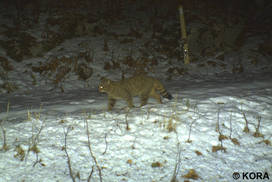
- European wildcat in the Jura Mountains, Switzerland.
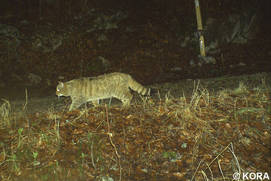
- European wildcat in its typical habitat, Jura Mountains, Switzerland.
Ecology and Behaviour
European wildcats are considered solitary, mostly nocturnal and territorial predators. In areas with little human activity, wildcats are often active also during the day, with activity peaks at dawn and dusk. In western Scotland, it was found that European wildcats can travel over 10 km per night to forage on open ground and rested in thickets or young forestry plantations during the day. Shelter structures near forest edges are preferred for resting sites. European wildcats often use burrows of other mammals, such as foxes or badgers, as den sites.
Home range sizes can vary considerably. For example, in Cabañeros National Park, Spain, home range sizes were found of up to 60 km2, whilst home range sizes in Hungary differed between 1.5-8.7 km². Home range size can vary dependent on different factors including prey availability, sex and seasonality. For example, in Scotland it was found that in areas with an abundance of rabbits, home range sizes can range from less than 1 km2 to about 6 km2. Whilst in Scottish areas where wildcats mainly rely on smaller prey like mice and voles, home range size was estimated at 8-18 km2. Additionally, males tend to have larger home ranges than females and usually male home ranges overlap with the ranges of 3-5 females. Home range overlap between individuals of the same sex, however, is low. For example, in an agricultural area in Germany, average home range sizes were 11.9 km2 and 2.9 km2 for males and females respectively. Similarly, in Maremma Regional Park and Paradiso di Pianciano Estate in central Italy, average male and female home ranges were estimated at 22.8 km² and 6.5 km². Home ranges too can vary based on seasonality. Males namely enlarge their home ranges during the mating season in the late winter and early spring, e.g. a male in Scotland enlarged its home range from 5 km2 to 25 km2 during that time. Females, on the other hand, enlarge their home ranges during summertime, when they are rearing their offspring.
European wildcats are influenced by competition and avoidance of larger felid species, such as the Caracal Caracal caracal and Caucasian lynx Lynx lynx dinniki, and canine species such as the red fox Vulpes vulpes and golden jackal Canis aureus. Generally, European wildcats only live in sympatry with larger felid species in habitats where they can take refuge from them. In Spain and France, wildcats have been found to spatially avoid red foxes and to be negatively affected by the recovery of the red fox population. Additionally, higher cortisol levels were found in European wildcats exposed to golden jackals, which possibly is a result from the interspecies competition for territory and food.
Not much is known about the social behaviour of the wildcat. There is evidence that individuals are in contact either by olfactory, vocal, or sometimes direct communication with at least their neighbours. The European wildcat uses scent marks (urine spraying in both sexes and uncovered faeces) for communication. Vocal communication occurs throughout the year, but most frequently in the mating season. The wildcat almost exclusively hunts on the ground, although it is an excellent climber, and usually stalks its prey followed by a quick attack.
The mating season is in late winter, namely between January- March. Most births take place in April and May. Females can only breed twice in one year under exceptional circumstances such as when the first litter is lost. The oestrus cycle lasts for 1-6 days when males are present and the gestation for 64-71 days, on average 68 days. Age at independence can vary from 5-10 months and sexual maturity is reached by females at 6.5-11 months and by males at 9-10 months. Kittens start to eat solid food when they are one month old, are weaned at the age of 3.5–4.5 months, and learn to hunt progressively between 3-5 months of age.
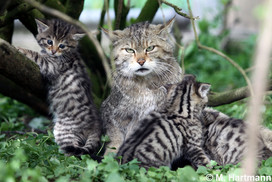
- European wildcat with its kittens.
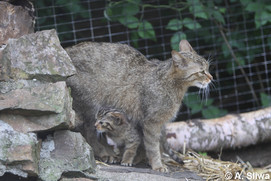
- Female wildcat with its kitten.
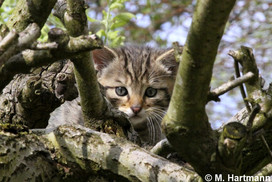
- European wildcats can climb quite well.
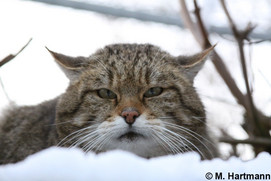
- Wildcat lying in the snow.
Prey
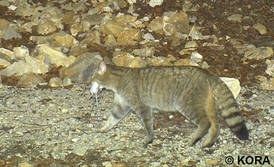
- European wildcat with a hunted mouse, Jura Mountains, Switzerland.
The staple diet of the European wildcat are rodents such as rats, mice and predominantly voles. In areas where rabbits occur such as central Spain or parts of Scotland, they tend to be the preferred prey of the European wildcat. The European wildcat occasionally predates on insectivores, birds, insects, frogs, lizards, hares and poultry or even smaller carnivores such as martens, weasels and polecats. They have also been found to be possible predators of European pond turtles in Slovakia. European wildcats also scavenge and cache food. The diet of the European wildcat shows only minor seasonal variations with rodents or rabbits as the major prey item throughout the year.
Main Threats
One of the main threats to the European wildcat is hybridisation with domestic cats which can lead to the loss of genetic variation or to the loss of specific adaptations. Such hybrids are found almost throughout its entire range and there may be very few genetically pure European wildcat populations remaining. The impact of hybridisation, however, is still not known and is being debated. Hybrids between wildcats and domestic cats can look very similar to the wildcat which makes it difficult to assess the status of the European wildcat.
Other potential threats to European wildcats include the disease transmission from domestic cats and competition with feral cats for food. Additionally, wildcats can be threatened by human-caused mortality. Many wildcats get killed on roads or as by-catch in control measures for other carnivores. Rodenticides may also threaten wildcat populations, e.g. 27% of collected cat carcasses collected from roads in Scotland had rodenticide concentrations at levels that would cause mortality in other species. Illegal persecution in predator control activities still occur in Iberia and in Scotland, the level of persecution, however, is not known.
In the 18th and through the mid-20th centuries habitat loss and fragmentation as well as direct persecution have led to sharp declines of European wildcats in Europe and Russia. Although the European wildcat can adapt to cultivated landscapes to a limited degree, habitat loss and fragmentation can still pose a problem. In some areas prey base reductions further threaten the wildcat. The risk of hybridisation with domestic cats is increased in cultivated landscapes.
Conservation Efforts and Protection Status
The European wildcat is included in CITES Appendix II, listed in the EU Habitats and Species Directive Annex IV, and the Bern Convention Appendix II. It is fully protected over most of its range under national legislation. Hunting is prohibited in Armenia, Austria, Belgium, Czech Republic, France, Germany, Greece, Hungary, Italy, Luxembourg, Moldavia, the Netherlands, Poland, Portugal, Spain, Switzerland, Turkey, United Kingdom, and Ukraine and regulated in Azerbaijan, Romania and Slovakia. It has no legal protection outside reserve areas in Bulgaria, Georgia and Romania. No information is available for Albania, Croatia and Slovenia.
The inclusion of the European wildcat into the Bern Convention and the European Habitat Directives has helped the species to recover in some parts of Europe after having sharply declined in many areas and been extirpated in others. The European wildcat re-colonized many countries between 1930 and 1940.
The most urgent conservation need is to identify genetically pure wildcats and to prevent hybridisation. However, this task is difficult as wildcats cannot easily be distinguished from domestic cats or hybrids. Further research on hybridisation levels may warrant a reassessment of the wildcat as a threatened species due to population declines of genetically pure wildcats. In Europe, progress has been made towards defining the felid “units of conservation”, combining studies of morphology and genetics to clarify the relationship between wildcats and domestic cats. Established morphological criteria and genetic markers should help to more easily distinguish hybrids from pure wildcats.
Additionally, there is a need for research on the metapopulation level. For the European wildcat, reliable information is available on population dynamics and change of the distribution range at local or national scale, but there is no consistent transboundary compilation or scientifically robust information at a metapopulation level. It is considered likely for threats and trends to differ between and within metapopulations, but no reliable and consistent information is available to test this assumption. Similarly, focus on wildcat conservation has been mostly local, with populations or metapopulations receiving uneven attention. In the case of Scotland, this reflects the critical status of the population, but otherwise is unrelated to the range expansion or assumed conservation status of the population. A review of the conservation status of the Scottish wildcat deemed the remaining population as not viable. The review recommended the strengthening of the remaining population with captive breeding and/or translocation from the genetically closest continental population.
